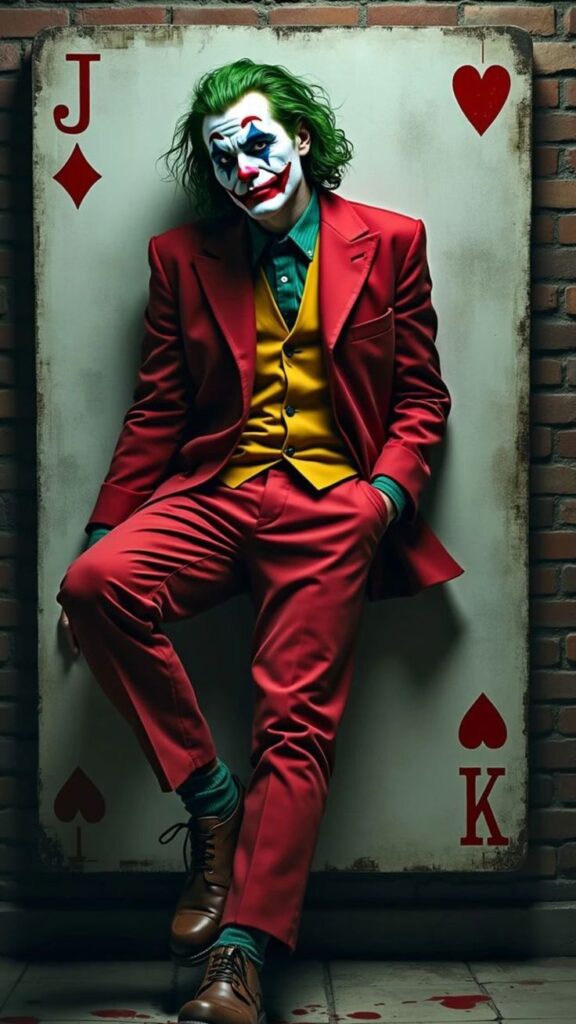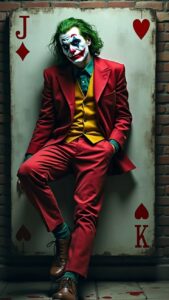When you picture Heath Ledger as the Joker, chances are the smeared white face paint, greasy green hair, and haunting red scars come to mind. But what happens when we strip all that away? What does the Joker without makeup reveal—not just visually, but psychologically and symbolically?
In this post, we’ll unpack Heath Ledger’s transformation, explore theories around the Joker’s true identity, and dig into why seeing him without makeup might be even more disturbing than the clown face we know.
Overview of the Joker’s Character
The Joker has always been more than just a villain. He’s a symbol of chaos, unpredictability, and moral ambiguity. His lack of a fixed origin story makes him an enigma—a mirror to the audience’s own fears and assumptions. Whether through comics, animated series, or live-action films, the Joker constantly reinvents himself.
Significance of the Joker’s Makeup
The Joker’s makeup isn’t just a costume—it’s a mask that amplifies his madness. In The Dark Knight, it becomes part of his psychological warfare. The way it’s applied—haphazardly, unevenly, almost like a child’s face-paint gone wrong—adds to his unhinged persona.
But what happens when you remove that paint?
Heath Ledger’s Joker in The Dark Knight

Ledger’s Joker isn’t just terrifying because of how he looks. It’s because of how he behaves: calm one second, erupting in violence the next, laughing at things no one else finds funny. His voice trembles unpredictably, his eyes twitch, his scars deepen every word with subtext.
But underneath all that is a face—Heath Ledger’s face—and it carries as much weight as the makeup itself.
Characterization and Performance
Ledger’s commitment to the role is legendary. He locked himself in a hotel room for weeks, developing the Joker’s mannerisms, voice, and twisted ideology. Some fans believe that when you look closely at scenes where the makeup is fading or smudged, the Joker without makeup becomes visible—not just literally, but psychologically.
Heath Ledger without Joker makeup is not just an actor stepping out of character—it’s a glimpse into a hollow man consumed by a role. That transition alone is nightmare fuel for many.
Makeup and Visual Transformation
The Joker’s scars are iconic, but the real horror may lie in how human he looks underneath. There’s something uncanny about seeing the Joker’s appearance without makeup—he looks… normal. And that’s what makes it disturbing. He could be anyone. A soldier. A banker. A neighbor. A guy on the subway.
In some behind-the-scenes footage and rare production stills, we see Ledger smiling without the face paint. It’s a jarring image—one that challenges our understanding of identity and performance.
Analyzing the Joker Without Makeup
Let’s be clear: this isn’t just about a physical transformation. The idea of the Joker without makeup invites psychological and cultural analysis. It forces us to confront the uncomfortable idea that evil doesn’t always come dressed in a costume.
Visual Description
Without makeup, Ledger’s Joker looks tired. Pale. Worn. His expressions become more subtle, yet somehow more menacing. This is where the term “Joker without makeup nightmare fuel” finds its footing. Seeing the man behind the monster reveals that the line between sanity and madness might be thinner than we think.
Audience Reactions and Interpretations
On Reddit, fans have long discussed what the Joker looks like under the mask. Threads like “Joker origin theory Reddit” and “Joker’s identity Reddit theories” speculate that removing the makeup doesn’t remove the character—it amplifies him. One user noted, “When he’s in makeup, he’s performing. When he’s not, he’s real—and that’s terrifying.”
This sentiment aligns with theories around the Joker’s PTSD, military background, and trauma history.
Theories Surrounding the Joker’s Identity
Military Background and PTSD
One popular fan theory suggests the Joker is a former soldier, suffering from PTSD. This would explain his combat skills, obsession with explosives, and deep mistrust of authority. The chaotic scars might not just be cosmetic—they could be remnants of war. This angle is central to the Joker PTSD theory and ties in with speculation about the Joker’s military background.
If true, the Joker’s makeup becomes a coping mechanism—a way to hide the trauma and reshape himself into something untouchable.
Psychological Profiles and Diagnoses
Psychologists and film analysts have speculated that Ledger’s Joker exhibits traits of multiple disorders, from antisocial personality disorder to schizophrenia. His inability to form meaningful connections, erratic behavior, and obsession with destruction all point to a fragmented psyche.
Removing the makeup doesn’t remove the pathology. In fact, it forces us to confront it more directly. No mask. No costume. Just a broken man, smiling.
Reddit Community Theories
Subreddits like r/FanTheories and r/MovieDetails are filled with discussions around the Joker’s hidden face. Many users note that “Joker without makeup analysis” is more unsettling because it humanizes him. “It’s easier to dismiss someone in clown paint,” one user wrote. “It’s harder when they look just like you.”
Others draw parallels to real-life individuals who committed acts of violence while appearing “normal,” underscoring the Joker’s relevance as a cultural symbol of fear.
Symbolism of the Joker’s Makeup
Cultural and Psychological Implications
The Joker’s makeup isn’t just for show—it’s symbolic. It represents his detachment from societal norms. In clown form, he can say and do what no one else can. The makeup gives him power, but also hides his vulnerability.
When it’s gone, the Joker becomes exposed. And in that exposure lies the deeper horror: he’s a man with nothing left to lose.
Comparison with Other Joker Portrayals
Jack Nicholson’s Joker was theatrical. Jared Leto’s was chaotic. Joaquin Phoenix’s was tragic. But Ledger’s Joker, particularly when imagined without makeup, stands apart. He doesn’t rely on a backstory. He doesn’t want pity. He’s pure disruption—and that makes him timeless.
Impact on Pop Culture
Influence on Fashion and Art
The Joker’s look—especially Ledger’s version—has inspired streetwear, editorial photography, graffiti, and cosplay. Even Joker without makeup has become an aesthetic of its own, seen in minimalist art and dark memes.
Memes and Internet Culture
Screenshots of Ledger’s Joker partially unmasked or in the middle of applying/removing makeup have spawned countless memes. They tap into themes of duality, identity, and emotional masking—perfect for the internet age.
Conclusion
Recap of Key Insights
- Heath Ledger without Joker makeup reveals a terrifying truth: the Joker isn’t just a villain, he’s a reflection of our own chaos.
- The absence of makeup humanizes the character but also makes him scarier—because he becomes real.
- Fan theories, especially on Reddit, suggest deep-rooted trauma, possible military PTSD, and fractured identity beneath the surface.
- The symbolism of the Joker’s makeup lies in its ability to both conceal and expose the man underneath.
Open Questions and Future Discussions
- Who was the Joker before the paint?
- Is the real madness found in his makeup—or beneath it?
- Could the Joker without makeup be an even more dangerous figure?
The answers aren’t clear. But one thing’s certain—Heath Ledger’s Joker, with or without the mask, changed cinema forever.





Pingback: Why Regular Reviews of Health & Safety Performance Are Needed - Snapspeak
Pingback: DIY Joker Green Hair Paint Tutorial: Complete Beginner’s Guide to Iconic Face Painting - Snapspeak